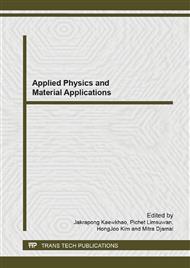p.254
p.258
p.262
p.267
p.271
p.275
p.279
p.283
p.287
Enhanced Deposition Rate of Photo-Induce Hydrophilic TiO2 Thin Films Prepared by Pulsed DC Reactive Magnetron Sputtering
Abstract:
Based on recent discovery of high-rate reactive magnetron sputtering, which was a key requirement for production of coating industry, this study focused on enhanced deposition rate of TiO2 films for photo-induce hydrophilic applications. The TiO2 thin films were reactively sputtered, which a pulsed DC source, from high-purity (99.995%) titanium (Ti) target on glass and silicon (100) and wafer substrates. During the deposition, a mesh grid cover was installed on the sputtering source with varying argon gas flow rates. Properties of the TiO2 films were compared between deposition with and without a mesh grid cover. The microstructure of the TiO2 films was studies by grazing-incidence X-ray diffraction (GIXRD) and field-emission scanning electron microscope (FE-SEM). The optical properties were determined by UV-Vis spectrophotometer. The contact angle measurement was used to determine the hydrophilicity of the films after exposing to UV light. For using the mesh grid during film deposition, it was found that the deposition rate of the TiO2 films was increased in oxide mode with a small grain size. In this case, the TiO2 films showed high transparent and good photo-induced hydrophilic properties.
Info:
Periodical:
Pages:
271-274
Citation:
Online since:
September 2013
Price:
Сopyright:
© 2013 Trans Tech Publications Ltd. All Rights Reserved
Share:
Citation:


